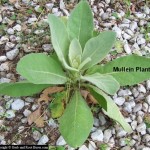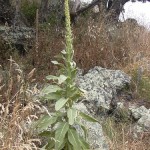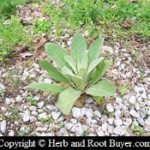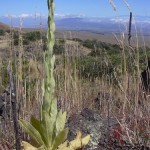Mullein – Verbascum Thapsus
|
Current Demand = Normal |
Parts Used: Herb |
 |
 |
 |
 |
Description:
The common mullein is a small hairy biennial plant that grows up to 2-4 feet. There are small yellow flowers that are densely grouped, like rosettes of wooly leaves and a tall thick stem. The flowers bloom from August to September. It is native to Europe, Africa, Asia and has been transplanted successfully to North America.
Planting/Cultivation:
Growing regions: Mullein leaf is common throughout the United States and if often found along roadsides, in pastures, fields and wastelands as well as timber trails and train tracks.
The plants are extremely prolific and bear seeds up to 180,000. It can sprout from bare ground and can grow shortly after forest fires and previous plants have died. Some plants die after the second year, if in the Northern planes, the plant may survive 3 years.
The plant prefers light, medium, and heavy soil that is well-drained. The plant likes acid, neutral and basic soils. It cannot grow in the shade and requires dry or moist soil.
Harvesting/Drying:
Parts Used: herb
Mullein leaf can be harvested any time as long as the leaf is green in color. Only the leaf is common for easy sale. Occasionally you can find a buyer for the flower and root. Cut or gently remove the whole leaf from the stalk and or root just above the surface of the ground. Mullein plants are easily hand pulled on loose soils due to relatively shallow tap roots.
This is an extremely effective method of reducing population and seed productivity, especially if plant is pulled before the seed sets. If blooms or seed capsules are present, reproduction structures should be removed, bagged, and properly disposed of in a sanitary landfill. Care should be taken, however, to minimize soil disturbance since loose soil will facilitate mullein seed germination.
Make sure all roots and foreign objects such as stones, grass or tree leaves are removed. In a warm dry area such as a barn loft or attic either place leaf collection in a thin layer on a screen if possible, or hang bunches of leaves together loosely in an onion sack.
When drying any leaf or herb avoid sunlight as this will bleach the color of your herbs and greatly decrease the value. If you prefer to hang your herbs for drying do not bag too tight or the leaf will mold or discolor. If drying on a flat surface turning daily is recommended to speed the drying process and discourage mold. Avoid combining fresh crops and dry or partially dry crops. When handling dried herbs take care to avoid crushing too many leaves and stems. Keeping dried plants in tact will often increase the value of your crop. The key to drying any roots, herbs or bark is an even combination of heat and airflow.
Once your herbs are completely dry (largest stem will snap not bend and leaves will crumble) place the herb carefully into a cardboard box or paper bag for storage in a dry area until you are ready to sell or use. Do not store the herbs in plastic or it will mold.
Attributes (Images)
 Root Buyer
Root Buyer